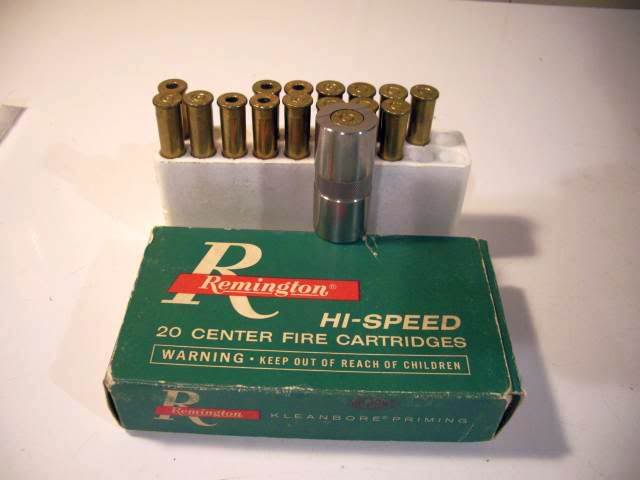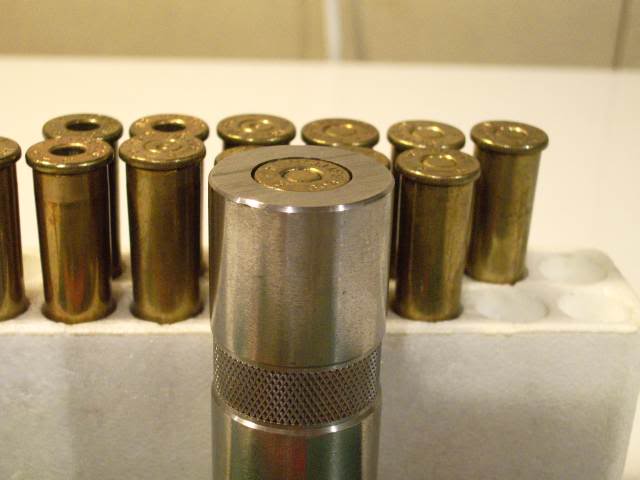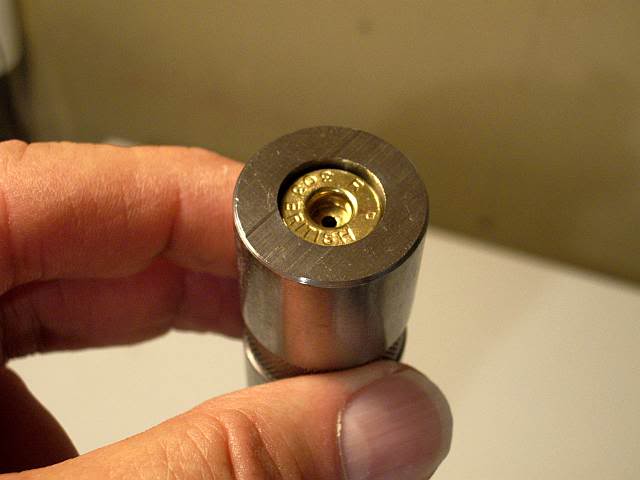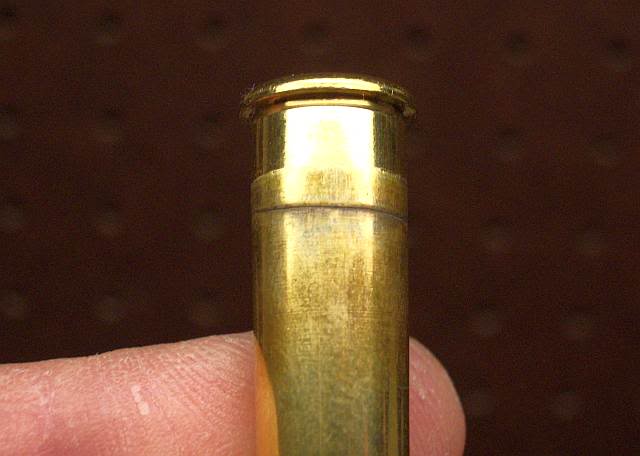-
The shoulder on a .303 is just there to confuse you.
-
-
06-05-2009 03:25 PM
# ADS
Friends and Sponsors

-
Advisory Panel


I like the expression "end play". Makes immediate sense as a mechanical engineering term, and avoids this irritating/confusing head business.
So we want zero end play. Or as near as we can get?
Patrick
-
-
That, as little sizing as possible and good brass!
-
-
Advisory Panel


Latest measurements
Having used the "9 para" method to measure the case shoulder movement, I have now applied the "pushed in primer" method to estimate the end play on 3 examples of the extended Enfield family. Measurements were made by holding the case in the lathe chuck and using the cross-slide to move a 1/100mm-reading dial gauge with rounded tip across the cartridge face.
End play:
No 4 Mk 2.....0.26 mm = 0.010"
No.1 Mk V.....0.20 mm = 0.008"
both with new cases
M1917..........0.06 mm = 0.0024" i.e. between 0.002" and 0.003" with a fired and neck-sized case. Bearing in mind that the bolt will compressed slightly on firing, and the brass has a slight spring-back, this is probably and low as one can get.
I know this is a slight case of comparing apples with pears, but I do not know in which rifle the fired 303 cases were used. I will remedy that next time.
The M1917 is "fed" only with the excellent cases from Geco. I have no idea how many times they have been fired. If they ever get too long they will be marked by a file notch when they are trimmed, and binned after two or three trimmings. On the basis of their performance to date, I think I already have a lifetime's supply.
Cases fired in both Enfields show the suspicious broad bright ring that indicates stressing of the body-base junction. As the animation provided by Parashooter shows, the body can expand quite freely in a radial direction, EXCEPT where it joins the base. This is usually where the cases come apart, and I suspect it is the radial stress at this junction that does the damage by causing a radial necking, not the longitudinal expansion. On the 303 cases there is a visible step at this junction after firing. Which would suggest that it is generous chamber diameter, not length, that causes the trouble. Further throughts on this would be welcome.
Patrick
-
-
Banned

-
Legacy Member


Originally Posted by
Patrick Chadwick

the body can expand quite freely in a radial direction, EXCEPT where it joins the base. This is usually where the cases come apart, and I suspect it is the radial stress at this junction that does the damage by causing a radial necking, not the longitudinal expansion. On the 303 cases there is a visible step at this junction after firing. Which would suggest that it is generous chamber diameter, not length, that causes the trouble. Further throughts on this would be welcome.
Patrick
Hi Patrick,
To test the same observation I have made cases from .30-40 Krag (.455 at the head) and .444 Marlin (.458 at the head after forming). The .444 Marlin brass is heavier than most .303 brass and the .444 Marlin is a more modern design with higher pressures than most rimmed cartridges designed for lever action rifles. These reformed cases look pretty ordinary after firing. There is no step or bulge at the pressure ring. My next task is to shoot some of these to destruction since they have not shown any ill affects with just a few reloads.
(.455 at the head) and .444 Marlin (.458 at the head after forming). The .444 Marlin brass is heavier than most .303 brass and the .444 Marlin is a more modern design with higher pressures than most rimmed cartridges designed for lever action rifles. These reformed cases look pretty ordinary after firing. There is no step or bulge at the pressure ring. My next task is to shoot some of these to destruction since they have not shown any ill affects with just a few reloads.
My hope for these tests is to prove that the huge diametral/radial clearance in the LE chambers contributes significantly to the reduced case life in the LE.
The tests involve the .30-40 Krag R-P case which is as thin as the .303 R-P case and weighs 162 grains. The 444 Marlin cases to be tested are much thicker at the pressure ring and the case weighs 190 grains.
It is my theory that the LE rifles suffer increased rate of case head separations due to:
1. Ammo to chamber fit has a lot of diametral clearance, (meaning .008 to.010 diametral clearance)
2. Generous headspace
3. Long head to chamber dimensions
4. Relatively springy actions.
One through three can be dealt with by various loading techniques.
Perhaps if they are all dealt with they will minimize the affects of #4.
If not, there may be a way to deal with #4 but it is sort of a last resort.
EDG
-
-
Advisory Panel


With full-power loads in rear-locking actions, even neck-sizing and good brass won't completely eliminate the small (.002"-003") amount of stretch that occurs because there is some 4" of elastic steel between bolt face and locking lugs/shoulders. The thinner the cross-section of bolt and receiver, the more stretch occurs. (That's why an SMLE flexes a bit more than a No.4 and a Remington 788 flexes less than any Lee action.) As JM noted earlier, the stretched section isn't corrected by sizing, it just keeps adding up. When accumulated stretch gets to about .020", our thinner cases are toast. Heavier ones can stretch more before they fail, but they'll give out eventually.
I don't have a P14 to demonstrate how front-locking helps reduce stretch in .303's, but once did a rough test comparing front-locking (K31) and rear-locking (K11) Swiss rifles for this effect. Even with substantially higher estimated peak pressure in the K31 load, cases lasted considerably longer in the front-locker.
rifles for this effect. Even with substantially higher estimated peak pressure in the K31 load, cases lasted considerably longer in the front-locker.
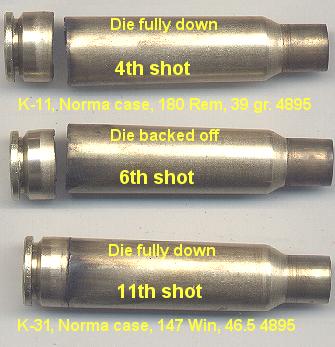
These cases were not new at the beginning of the test, but had comparable histories. Norma 7.5 brass is surprisingly soft and light compared to some others -
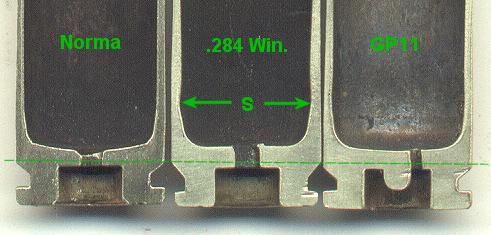
This .284 case has been fired a lot in rear-locking actions, but is so thick-walled it still has a long life ahead.
As far as I know, there are two ways to extend case life in Lee-Enfields, beyond the normal methods of neck/minimal sizing and using improvised rim spacers on initial firing of new brass:- Use reduced-pressure loads to minimize action flex.
- Lube cases - with the caveat that many respected sources consider this hazardous to rifle and shooter.
Patrick, I can't agree with ". . .it is generous chamber diameter, not length, that causes the trouble. . . " Head separations occur when we have end-play and/or action flex, even with cases that are a tight fit in the chamber (like the 7.5's above). Also, sectioned cases show that the thinning occurs well above the point where walls expand to fill chamber, as can be seen on the well-worn Winchester and Federal cases in this picture -
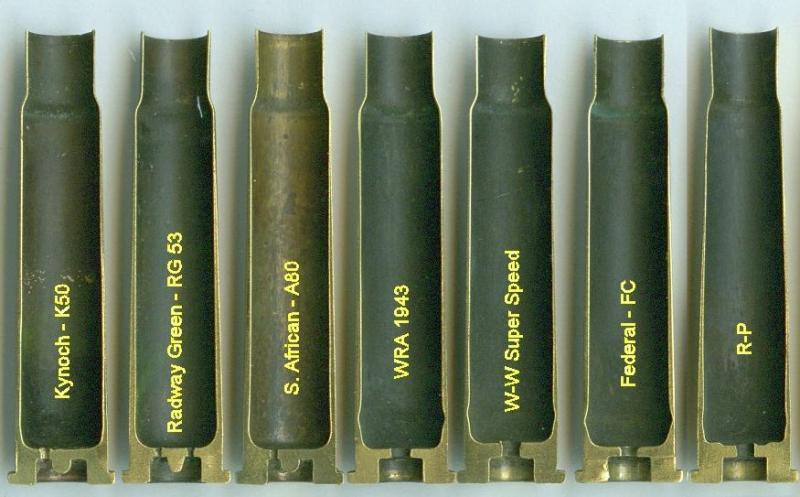
Ed, I think you're on to something with the old/new comparison but I'm not convinced it's the quality of the raw material that has changed. Is is possible the new cases are just thinner and lighter? Have you compared weights and wall thickness between the two "generations" of R-P cases?
-
Thank You to Parashooter For This Useful Post:
-
Banned

Parashooter
I checked some different cases for weight
S&B 182 grain avg
Privi 172 grain avg
Win 169 grain avg
Rem 162 grain avg
There was only at most 1 grain difference between the old and new Remington cases????
The Winchesters weigh more than the Remingtons but longevity is the worst
The Privi bases are .010 thicker than the Rem or Win and the base diameter is larger.
Fire forming with the rubber o-ring method produced cases without any thinning or stretching in the web area, and the o-ring centers the base of the case in the chamber.
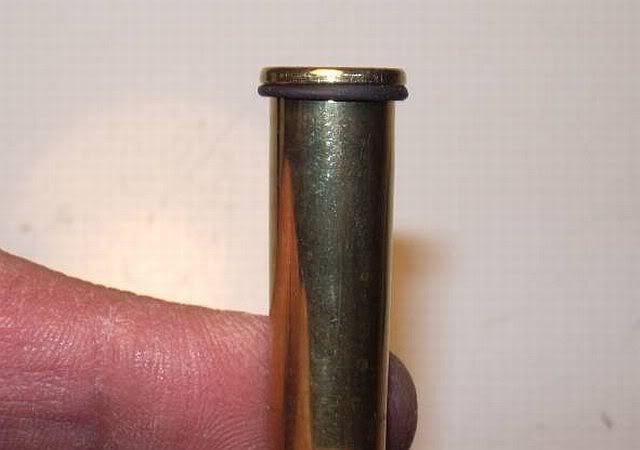
-
Legacy Member

Now we are getting somewhere. Comparison new cases verses new old cases. The composition of the brass has been changed. Eds thoughts on this have paralleled my experiences. I agree with most of what has been said but it comes down to one common denominator the case.
-
-
Legacy Member

>>>The composition of the brass has been changed<<<
This is not proven.
My experience of 35 years ago gave results just as poor as is common today with the same brands of brass.
-

















 PM
PM





